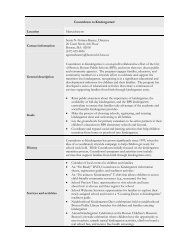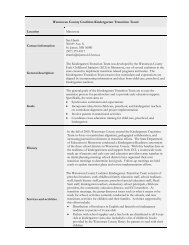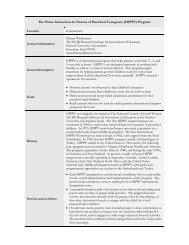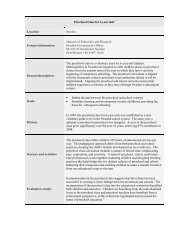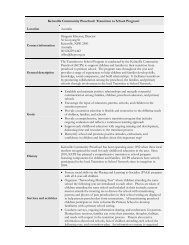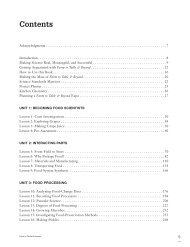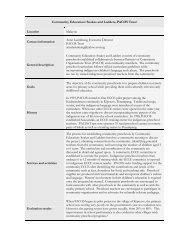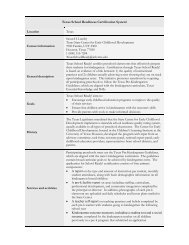Proceedings of the Fourth Annual Teachers College Educational ...
Proceedings of the Fourth Annual Teachers College Educational ...
Proceedings of the Fourth Annual Teachers College Educational ...
You also want an ePaper? Increase the reach of your titles
YUMPU automatically turns print PDFs into web optimized ePapers that Google loves.
Gone in an Instant: Using Visual Media to Improve Teacher<br />
Pr<strong>of</strong>essional Practice Participation<br />
Dino Sossi,<br />
<strong>Teachers</strong> <strong>College</strong>, Columbia University, 525 West 120 th Street, New York, NY, 10027,<br />
Email: dds2130@columbia.edu<br />
Abstract: The unrelenting demands <strong>of</strong> <strong>the</strong> typical public school environment conspire<br />
against <strong>the</strong> educator who aspires to be reflective in her practice. It is simply difficult to<br />
have <strong>the</strong> time as well as <strong>the</strong> ability to revisit ei<strong>the</strong>r <strong>the</strong> content or <strong>the</strong> pedagogy that are<br />
<strong>the</strong> constituent elements <strong>of</strong> instructional practice. Fortunately, technology can play a<br />
positive role in assisting <strong>the</strong> conscientious, but overburdened, educator. Low-cost,<br />
consumer digital video equipment allows an increasingly diverse group <strong>of</strong> people to<br />
record <strong>the</strong>mselves regardless <strong>of</strong> situations. Within an educational environment,<br />
unobtrusive, economical video cameras allow teachers to document <strong>the</strong>ir own practice.<br />
Educators can record aspects <strong>of</strong> school-life without <strong>the</strong> distraction inherent to large-scale<br />
video production. This exploratory work-in-progress focuses on a pair <strong>of</strong> 2nd Grade<br />
Collaborative Team Teaching (CTT) educators who recorded instruction within <strong>the</strong>ir<br />
classroom to promote in-service self-reflection.<br />
Introduction<br />
The onset <strong>of</strong> low-cost, easy-to-use digital video production equipment has allowed an increasingly diverse<br />
group <strong>of</strong> people to record <strong>the</strong>mselves in an even wider array <strong>of</strong> situations. Cheaply-priced, compact-sized<br />
video cameras allow teachers to become <strong>the</strong>ir own video documentarians. As a result, educators can<br />
record various aspects <strong>of</strong> school-life without <strong>the</strong> distraction <strong>of</strong> video production crews or large, weighty<br />
and highly intrusive recording equipment. This research project focuses on teacher-recorded instruction<br />
within a 2nd Grade Collaborative Team Teaching (CTT) Science classroom to promote teacher selfreflection.<br />
This research is set within <strong>the</strong> context <strong>of</strong> a Science, Technology, Engineering and Ma<strong>the</strong>matics<br />
(STEM) education program situated in a poor urban elementary school.<br />
Methods<br />
There were a variety <strong>of</strong> research methods implemented within this study. The main method utilized<br />
included <strong>the</strong> Collaborative Team <strong>Teachers</strong> (CTT) who instruct <strong>the</strong>ir class using video cameras to<br />
document <strong>the</strong> progress <strong>of</strong> <strong>the</strong>ir lessons. They teach a 2nd Grade class including Science. After <strong>the</strong>y<br />
finished shooting <strong>the</strong> footage, <strong>the</strong> classroom teachers were provided with a series <strong>of</strong> guiding questions to<br />
help frame <strong>the</strong>ir analysis <strong>of</strong> <strong>the</strong> video that was captured. The areas <strong>of</strong> research interest included thoughts<br />
about <strong>the</strong> lessons <strong>the</strong>y gave as a whole, <strong>the</strong> strengths <strong>of</strong> <strong>the</strong>ir instruction, <strong>the</strong> modes <strong>of</strong> assessment used<br />
within class, <strong>the</strong> changing levels <strong>of</strong> student engagement during class, as well as possible avenues <strong>the</strong>y<br />
could explore in terms <strong>of</strong> pedagogy. Also, teachers were directly asked if <strong>the</strong> process <strong>of</strong> video recording<br />
had any effect on teacher self-reflection as well as pr<strong>of</strong>essional development and, if so, what was it. Due<br />
to <strong>the</strong> first-person nature <strong>of</strong> <strong>the</strong> shooting, <strong>the</strong> video largely covered student-student interaction and<br />
teacher-student interaction when children were prompted as well as improvised student utterances.<br />
In terms <strong>of</strong> <strong>the</strong> demographics <strong>of</strong> this particular class, <strong>the</strong> study was situated within a 2nd Grade Science<br />
program mandated by an urban public school board where it operated. The word “urban” is used as a<br />
means to describe <strong>the</strong> demographics, physical location and socioeconomic status <strong>of</strong> <strong>the</strong> school’s<br />
clientele. This elementary school receives Title 1 funding with 89% designated as being eligible. The<br />
school is a Pre-Kindergarten through 5th Grade elementary school was located in a large metropolitan<br />
city. In order <strong>of</strong> decreasing percentage <strong>of</strong> representation, students were 79% Hispanic, 18% Black, 2%<br />
White and 0.2% Asian students. Student participants were enrolled in <strong>the</strong> 2nd grade. The subject matter<br />
involved Science.<br />
Evidence<br />
69



